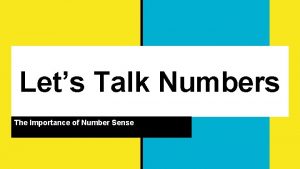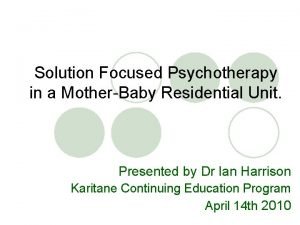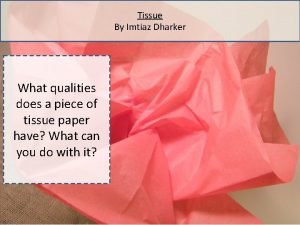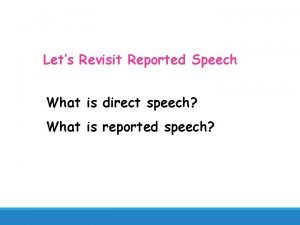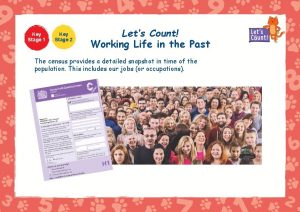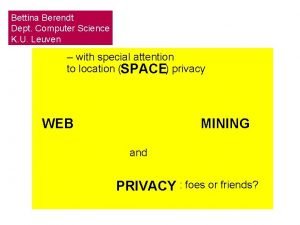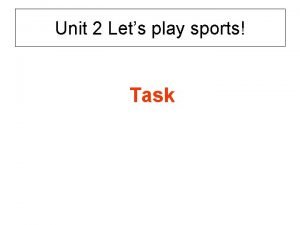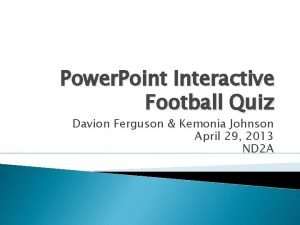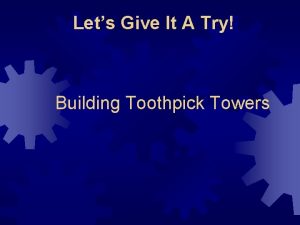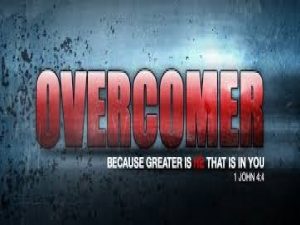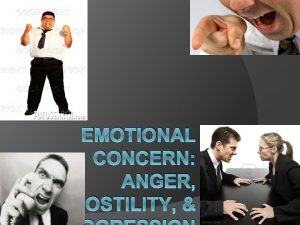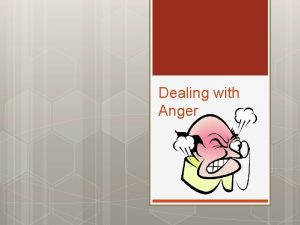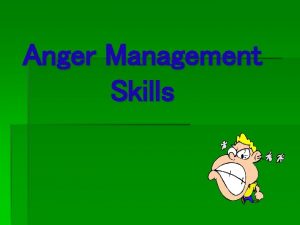Lets Talk ANGER MANAGEMENT ANGER MANAGEMENT Anger management
























- Slides: 24

Let’s Talk ANGER MANAGEMENT

ANGER MANAGEMENT Anger management does not involve getting rid of all anger, but using anger to enhance your life. We can look at the purposes of anger in both a positive and negative light. 2

ANGER MANAGEMENT The positive aspects of anger are you have increased energy, are able to communicate your feelings, able to problem solve and can take charge of the situation. 3

ANGER MANAGEMENT The negative aspects of anger are you can have disruption of your thinking, unnecessarily defend yourself, become aggressive and become known as an angry person. 4

ANGER MANAGEMENT Anger management is a way to increase the positive aspects of anger and decrease the negative aspects of anger. 5

ANGER MANAGEMENT Know the difference between ANGER and AGGRESSION. 1. Anger is an emotion. It is ok to be angry. It is part of being human. 2. Aggression is acting out inappropriately and is not ok. Learn to check your aggression and express your anger appropriately. 6

Taking off the masks Sometimes anger really is … • • Embarrassment Shame Disappointment Jealousy Fear Helplessness Sadness Feeling left-out 7

ANGER MANAGEMENT You are in charge of your own feelings: 1. You own your feelings. 2. It is okay to feel angry. 3. Anger is part of being human. 4. Learn how to express your anger in helpful ways. 8

ANGER MANAGEMENT Do you show anger in aggressive ways? Do you…. . • • Throw things Kick people or things Get in someone’s face Shove, grab or hit Break things Call people names Give someone a dirty look • Give people the silent treatment • Get others to “gang up” • Spread rumors 9

ANGER MANAGEMENT Choose to feel good about yourself by expressing your feelings. Express your feelings in ways that are fair to others and yourself. Use fair words…such as “I feel…” 10

ANGER MANAGEMENT The more you learn to take care of your anger the more powerful you become. 1. You need to control what you do with your anger. 2. You control how you let your anger out. 3. Practice cooling off. 4. Watch your thoughts. 11

ANGER MANAGEMENT • Identify possible consequences of your anger to others and yourself. What can that mean for you? • Physical harm to someone or self • Destruction of property • Loss of friends • Loss of social privileges • Getting a bad reputation • Going to juvenile hall 12

ANGER MANAGEMENT • Identify selfdestructive behavior. • Negative self-talk • Blaming everyone else • Taking everything personally • Assuming • Looking for fights • Feeling outraged • Self-injury • Overeating, drinking • Taking drugs 13

ANGER MANAGEMENT Stop blaming others and yourself. 1. Blaming only keeps people upset. 2. Blaming is a way of not respecting people. 3. Express your feelings and then try to work things out. 14

ANGER MANAGEMENT What do you think before your angry actions? Do you think … • • • You did that on purpose… You wanted to hurt me… You deserve this… You never even asked me… You’re being unreasonable… You think you’re so good… I’ll show you… You started it… It’s not fair… 15

ANGER MANAGEMENT Identify how you physically feel when you are angry • Stomach gets tight/upset • Heart beats faster • Clench fists • Feel yourself getting flushed • Pressure on your temples • Sweaty palms • Clenched jaw 16

ANGER MANAGEMENT You don’t have to hold on to your anger. 1. Find ways to let it go. 2. Talk about hurt and angry feelings. 3. Look for someone to discuss your anger. 17

Take control of your anger 1. Stand up for yourself and others being hurt. 2. Learn to defeat negative self-talk. 3. Feel good about learning about yourself. 4. You are strong when you use fair and firm words instead of fists. 18

Steps to taming anger 1. Know what pushes your buttons. 2. Know your body’s anger signs. 3. Stop and think! 4. Decide what to do. 19

ANGER MANAGEMENT 1. 2. 3. 4. 5. 6. Ways to Calm Down: Exercise. Eat right. Get enough sleep. Learn to relax. Know your feelings. Write about those feelings. 20

ANGER MANAGEMENT 7. 8. 9. 10. Find a quiet place. Take a time out. Find fun distractions. Make good decisions about what you see and hear. 11. Choose friends who make you feel good. 12. Learn to forgive and forget. 21

Conflict resolution steps: 1. Calm down 2. Identify the problem 3. Find solutions 4. Pick the best solution 5. Evaluate the solution 6. Make changes if necessary 22

Remember people are precious. 1. Watch your thoughts, words, and actions. 2. Stop hurting people with your words and actions. 3. Take ownership of the hurtful things you do and say. 4. “Bullying” hurts everyone. 23

24
 Lets talk about sports
Lets talk about sports Uwe careers service
Uwe careers service Let's talk numbers meaning
Let's talk numbers meaning Talk, read talk write template
Talk, read talk write template Amateurs talk tactics professionals talk logistics
Amateurs talk tactics professionals talk logistics The words use are not
The words use are not Paper thinned by age or
Paper thinned by age or Mutually assured destruction cartoon
Mutually assured destruction cartoon Lets copy saldanha
Lets copy saldanha Let's think in english
Let's think in english You already know in spanish
You already know in spanish Reported speech lets
Reported speech lets Lets review cartoon
Lets review cartoon Song lets just kiss and say goodbye
Song lets just kiss and say goodbye Lets count jobs
Lets count jobs Lets fight it together
Lets fight it together Lets be copd
Lets be copd Lets leuven database
Lets leuven database What is benchmarketing
What is benchmarketing Icivics we're free let's grow answer key
Icivics we're free let's grow answer key Lets play sports
Lets play sports Let's watch a video
Let's watch a video Davion ferguson
Davion ferguson Let's practice meaning
Let's practice meaning Strongest marshmallow and toothpick tower
Strongest marshmallow and toothpick tower


